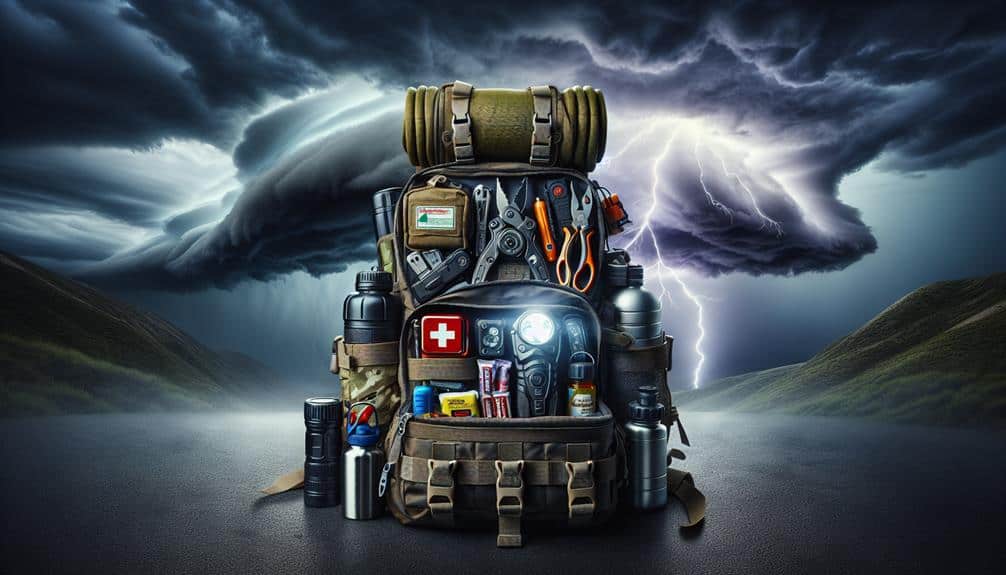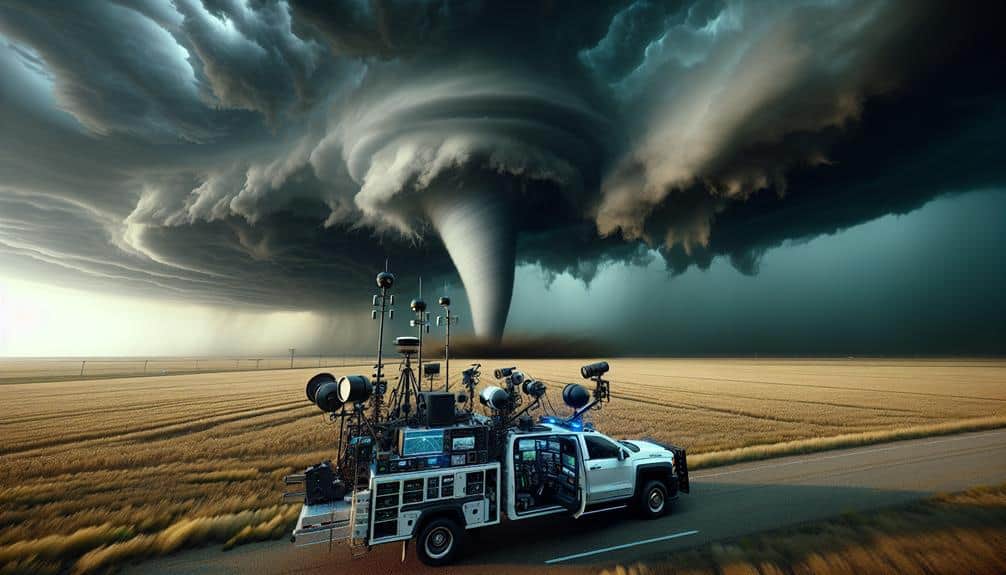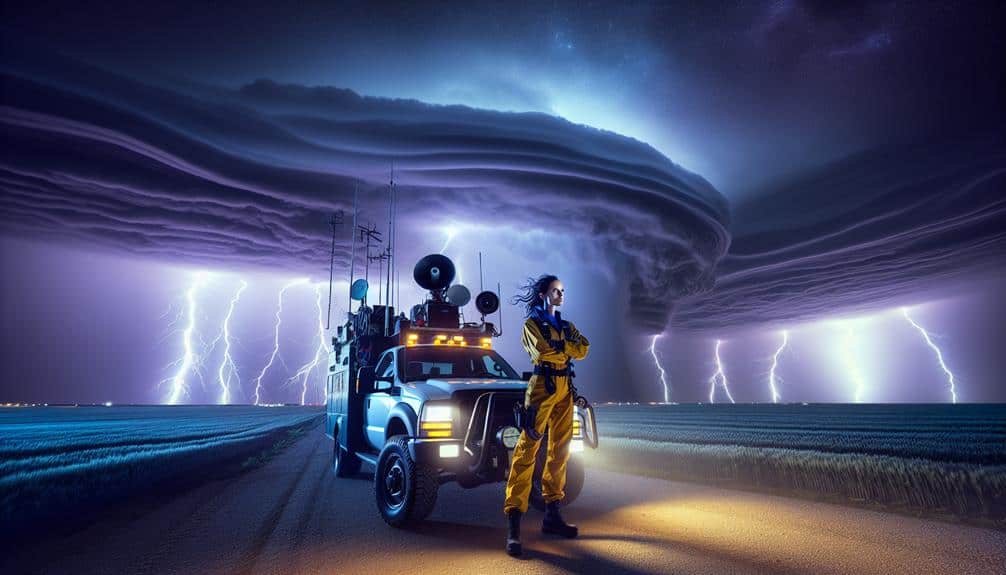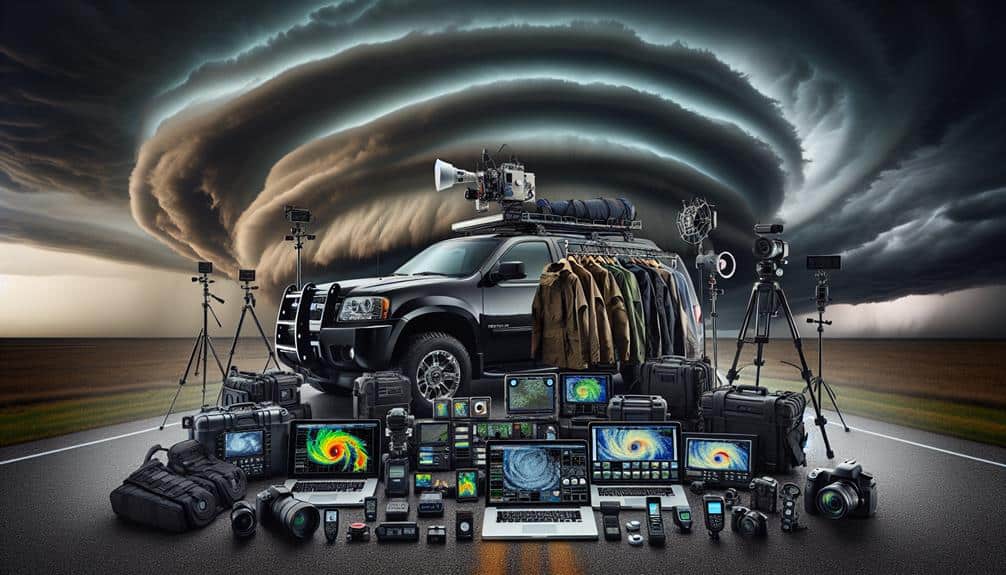In storm chasing, we rely on top gear essentials to guarantee safety and precision in unpredictable conditions. Reliable weather radios, equipped with SAME technology, provide real-time updates vital for situational awareness. Durable outerwear, featuring materials like Gore-Tex and Thinsulate, offers protection against harsh weather. Advanced camera equipment with robust weather sealing captures high-resolution imagery, while navigation tools like GPS and GIS optimize our route planning. Essential emergency supplies, including first aid kits, personal locator beacons, and portable power banks, are essential for preparedness. To fully understand the intricacies of this essential gear, there's a deeper exploration ahead.
Key Points
- Reliable weather radios provide real-time severe weather alerts using Specific Area Message Encoding (SAME) technology.
- Durable outerwear like waterproof jackets and insulated boots protect from rain, sleet, and high-velocity winds.
- Advanced camera equipment with weather sealing and fast shutter speed captures high-resolution images and videos.
- Navigation tools, including GPS systems and traditional compasses, ensure accurate tracking and interception of weather systems.
Reliable Weather Radios
A reliable weather radio is an indispensable tool for storm chasers, providing real-time alerts and important updates on severe weather conditions. Utilizing various radio frequencies, these devices keep us informed of rapid changes in weather patterns, necessary for accurate storm tracking. Advanced weather radios are equipped with Specific Area Message Encoding (SAME) technology, which allows us to receive alerts for designated areas, ensuring we only get relevant information.
Effective communication methods are essential when we're out in the field. Weather radios serve as a crucial link to the National Oceanic and Atmospheric Administration (NOAA) Weather Radio All Hazards network, broadcasting continuous weather information directly from the nearest National Weather Service office. This direct line of communication enhances our situational awareness and helps us make informed decisions.
Safety measures are paramount in storm chasing. Weather radios often come with features like automatic alerts and battery backup, ensuring we don't miss important warnings even if power sources fail. By staying attuned to the latest updates, we can better navigate hazardous environments, reducing risks and optimizing our storm tracking efforts.
This blend of technology and preparedness allows us the freedom to pursue our passion safely and effectively.
Durable Outerwear
When we're out in the field, durable outerwear is essential to withstand the harsh conditions and unpredictable elements we encounter during storm chasing. High-quality waterproof jackets are a non-negotiable item in our gear. These jackets are designed to repel rain and sleet, guaranteeing we remain dry and focused on tracking the storm.
Advanced materials like Gore-Tex provide both breathability and impermeability, crucial for maintaining comfort during prolonged exposure.
Insulated boots are another cornerstone of our storm-chasing attire. These boots provide thermal insulation to protect our feet from cold temperatures and damp conditions. Materials such as Thinsulate ensure peak warmth without adding unnecessary bulk, allowing for agile movements.
Windproof pants are indispensable for shielding us from high-velocity winds that can sap body heat and impede mobility. These pants often incorporate advanced fabrics like Windstopper, which offer both wind resistance and breathability, guaranteeing our lower extremities remain warm and dry.
Advanced Camera Equipment
Capturing the raw power of nature during a storm demands advanced camera equipment that can withstand extreme conditions and deliver high-resolution imagery. We need cameras with robust weather sealing to shield against rain, wind, and dust. Full-frame DSLRs or mirrorless cameras with high dynamic range (HDR) capabilities are essential for capturing the intricate details of lightning bolts or the swirling patterns of a tornado.
For best results, understanding and adjusting camera settings is vital. We often use manual mode to control exposure, shutter speed, and aperture precisely. A fast shutter speed, around 1/1000th of a second, can freeze lightning strikes, while a slower shutter speed might be used to capture the motion of storm clouds. Techniques such as bracketing can also help capture a broader range of light intensities.
In addition to still photography, capturing video footage demands high-frame-rate capabilities, preferably 60 frames per second or higher, to optimize smooth playback.
Once we've the raw footage, video editing software like Adobe Premiere Pro or Final Cut Pro allows us to enhance, stabilize, and color-correct our captures, ensuring the final product is as breathtaking as the storm itself.
Effective storm chasing requires precise and reliable navigation tools to guarantee we can track and intercept severe weather systems safely and efficiently. The cornerstone of our navigational arsenal is undeniably GPS systems. These devices provide real-time geospatial data, enabling us to monitor our exact location relative to the storm. High-quality GPS systems with advanced features, such as terrain mapping and waypoint tracking, are indispensable. They guarantee we can anticipate road closures and detours, optimizing our route to stay ahead of the storm's path.
While GPS systems are paramount, we shouldn't neglect the reliability of traditional compasses. These analog tools serve as a fail-safe when electronic devices falter due to signal loss or power failure. A compass, coupled with a detailed topographic map, offers an additional layer of security, letting us navigate through unpredictable terrains with confidence.
Moreover, integrating geographic information systems (GIS) with our GPS units enhances our ability to analyze spatial data, giving us an edge in storm prediction and planning. By leveraging these sophisticated navigation tools, we maintain the freedom to chase storms effectively while minimizing risks.
The synergy between GPS systems and compasses guarantees we're always oriented, prepared, and ready for whatever nature throws our way.
Emergency Supplies

Having robust navigation tools in place, we must also prioritize carrying thorough emergency supplies to guarantee our safety amidst the unpredictable and often hazardous conditions of storm chasing. Our survival kits should include first aid essentials, multi-tools, thermal blankets, non-perishable food, and water purification tablets. These items are essential for sustaining us if stranded or delayed due to severe weather conditions.
In addition to survival kits, reliable communication devices are indispensable. A multi-band radio, capable of receiving NOAA weather updates, keeps us informed about real-time weather changes. Satellite phones serve as a strong backup, ensuring we maintain communication even when cellular networks fail. Personal locator beacons (PLBs) can transmit distress signals to emergency services, providing an additional layer of safety.
Moreover, portable power banks and solar chargers should be part of our emergency supplies to keep our devices operational. Having these power sources guarantees our communication devices and navigation tools remain functional throughout our storm-chasing expedition.
Frequently Asked Questions
What Type of Vehicle Is Best Suited for Storm Chasing?
The best vehicles for chasing storms are modified SUVs or trucks. They offer durability, off-road capability, and advanced weather tracking systems. We need reliable transportation to navigate hazardous conditions and collect accurate meteorological data efficiently.
How Can I Stay Connected to the Internet in Remote Areas?
Picture being an island in a sea of data; we can stay connected using satellite internet and portable hotspots. These tools guarantee reliable internet access in remote areas, providing freedom to roam without losing connectivity.
Are There Any Specific Apps Recommended for Storm Chasers?
We recommend weather tracking apps like RadarScope for precise data, and MyRadar for real-time visualizations. For safety alerts and emergency communication, download Storm Shield. Use Periscope for live streaming to stay connected with the world.
What Safety Protocols Should Be Followed During a Storm Chase?
When we pursued last spring, our communication failed, but finding emergency shelters saved us. Always follow safety precautions like having emergency supplies and reliable communication. Prioritize data-driven decisions to guarantee freedom without compromising safety.
How Can I Predict the Best Locations for Storm Chasing?
To predict the best locations for storm chasing, we analyze weather patterns and forecasting models, considering topography and terrain. We utilize satellite data, Doppler radar, and atmospheric conditions to pinpoint high-probability areas for severe weather events.


